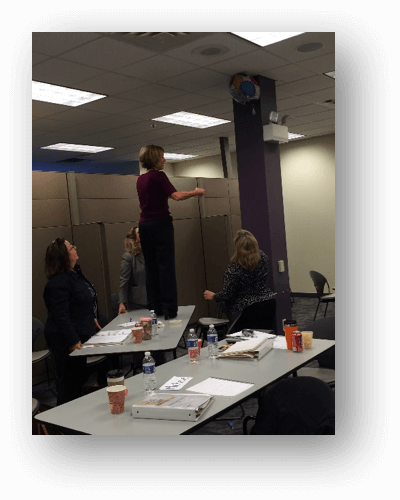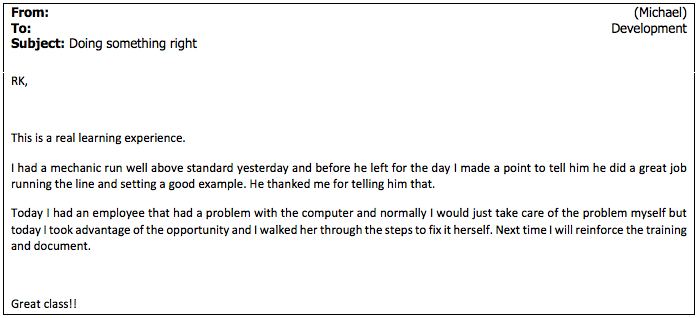Experiential training methods and activities breaks away from the boring, traditional way to learn…even in a corporate environment.
When I first entered the workforce, I did what nearly every other employee ever did. I sat in a back room, watching videos, (that had probably been made when I was five or six), and waited for the trainer to either put another video in, or read to me from the book he or she had given me at the beginning of the day. Next, I was given ‘the quiz’, wherein I was asked to prove that I had watched the videos and read the book. This can’t be what experiential training methods and activities is all about, is it?
Here’s what I actually learned:
Training was…well…boring.

A woman standing on a desk participating in experiential learning.
And, once I was free…I mean…’done’ with the training, I would go to my new station, cubical or office and try to figure out my job. Luckily, inevitably, someone would walk up to me and say something like: “O.K. now that you’re out of training let me tell you what you really need to know.”
I’m certain that this experience with training only has only happened to me right?
Like everyone else, I thought: “Was I trained?”
For years many people and companies believed that experiential training methods and activities meant a facilitator standing in front of a class of participants, usually new hires, and having employees divide their time between looking down at the information written, and looking up at the facilitator, (usually reading the same aloud information), in order to seem interested.
Is that training?
For most, the answer is unequivocally yes.
For others, it is a slow, painfully boring form of torture.
The Gool ‘Ol Days…Before Experiential Training Methods and Activities
When I first became a corporate trainer, for a corporation that ran restaurants, I was given simple instruction: “Read a paragraph, or even a page, and then call on one of the employees to read the next one. Then show the number, (insert a number here), video, followed by the quiz. And you know, make it fun.”
Interestingly enough, this was the same formula for training seasoned employees. With a couple of exceptions; major amongst these was: “Do this ice-breaker first, and, after the videos give them this test. If they fail, they will have to take it again…or we fire them.”
Is that training?
Again, it depends upon whom you ask. Some people learn this way. Others…well, not so much.
Let’s be even clearer.
If you can sit in a training room, not engage with your fellow trainees, and never actually speak to the person at the front of the room, you are being presented with information.
Much like sitting in on a meeting where you’re not sure you should be in the room, training that does not engage the trainees in the room, is often questionable.
In this age of metrics, and increasing measurable ROI, it’s still quite astonishing that many company cultures don’t know the difference between having a presenter, a facilitator, and a trainer.
In fact, many still consider a training classroom to be an extension of a school classroom.
This is akin to believing that a team-leader, a supervisor and a manager all do the same thing.
Let’s be Crystal Clear
Presenter:
A presenter, also referred to in the industry as a ‘Vanna White’, is someone who usually has no connection to the information being presented, nor a voice in the methods in which it is presented. They are there to ensure that all of the prescribed steps are checked off a training checklist, and to keep talking and sleeping to a minimum. This person usually learns the content of the material along with the class, and is discouraged from straying from the approved ‘script’ by answering questions about specific departments, people and the culture of the company itself. This is good for a company, and employees for whom metrics have shown learn better via videos, CBT or Computer Based Training. For many presenters, they have been given specific instructions on how to conduct the initial encounter with their attendees, (the icebreaker), and are usually given TCM’s, (Time-based Completion Markers), for when the training presentation needs to be concluded.
Facilitator:
A facilitator is someone who may or may not have had any input into the current information they are giving. They have studied the data before the training encounter, and, are able to quote it nearly verbatim. The facilitator can call upon other resources such as asking other SME’s, (Subject Matter Experts), into the room to give information on specific aspects of the knowledge needed to be transferred, and can innovate new icebreakers as well as answer questions concerning the company culture. The facilitator will also keep track of ‘dead’ information, that is videos and learning content that is no longer valid, and is empowered to change this information, with approval, in order to keep the material up to date with current company policies. The mark of a great facilitator is usually his or her ability to make the information seem ‘new’ every time.
Trainer:
A trainer is someone who understands the difference between Pedagogy and Andragogy. They understand the information to be given, they usually have a notebook, or binder, which they refer to, or carry around during the learning event, full of information designed to capture, and enhance the material as well as the learning experience.
While time is still a factor in their class, they are more concerned with imparting useful information and keeping the trainees interested. This method of training puts the onus on the trainer, and how much information they can cover in the time given, rather than on the learner’s accountability for asking questions and understanding the skills or knowledge necessary to be successful. In order to be called a trainer, they will usually have some formal education in adult learning principles and know that Kirkpatrick and SWOT are not from Star Trek or…that movie with LL Cool J.
Experiential Trainer:
An experiential trainer is someone who: Understands that this discipline has been around since around 352 B.C. although most early experiential training methods and activities took place in the great outdoors of some kind, the theories and activities are not limited to this venue. To quote Ryerson University’s Michelle Schwartz, (http://www.ryerson.ca/content/dam/lt/resources/handouts/ExperientialLearningReport.pdf)
Assessing Experiential Training Methods and Activities
There are many potential ways to assess experiential activities, both external and internal. These methods are connected to reflection, helping learners to focus their learning while also producing a product for assessment purposes. Moon lists several examples:
- Maintenance of a learning journal or a portfolio
- Reflection on critical incidents
- Presentation on what has been learned
- Analysis of strengths and weaknesses and related action planning
- Short answer questions of a ‘why’ or ‘explain’ nature
- A project that develops ideas further (group or individual)
- Self-evaluation of a task performed
- An article (e.g. for a newspaper) explaining something in the workplace
- Recommendation for improvement of some practice (a sensitive matter)
- An interview of the learner as a potential worker in the workplace
- Essay or report on what has been learned (preferably with references to excerpts from reflective writing)
- Self-awareness tools and exercises (e.g. questionnaires about learning patterns)
- A review of a book that relates the work experience to own discipline
- A story that involves thinking about learning in the placement
- A request that students take a given theory and observe its application in the workplace
- An oral exam
- Management of an informed discussion
- A report on an event in the work situation (ethical issues)
- Account of how discipline (i.e. subject) issues apply to the workplace
While the experiential trainer won’t hit each of these assessment methods, they understand that each of them need to be considered when an experiential learning event is to take place.
Each trainer knows the information or material well enough to have ‘wiggle’ room in order to include the participants in the learning that will take place. At the beginning of the training session, they can usually be found interacting with the trainees, (now called ‘participants’ due to the need for them to participate in the learning event), in an attempt to begin to understand each person’s personality and needs. The experiential trainer usually knows this statement from Confucius by heart:
“TELL ME AND I WILL FORGET, SHOW ME AND I MAY REMEMBER, INVOLVE ME AND I WILL UNDERSTAND”
~CONFUCIUS
The experiential trainer has a long history of education and learning from which to draw, and will readily change the learning environment in order to help the needs of the participants. They understand that adult learning, like all learning, is discovery and requires a personal investment from the learner. Put another way: which do you remember, how to conjugate a verb for the first time, or how to kiss?
According to the UK’S SKILLS CONVERGED, (http://www.skillsconverged.com/), a training materials company:
Experiential learning focuses on learning for the individual. As an example, imagine explaining how a software tool works by describing it as opposed to allowing the learner to use the tool to acquire first-hand experience. Similarly for soft skills training, Experiential Learning means placing the learner in a relevant context, roleplaying a particular situation or going through a difficult conversation while understanding what works and what doesn’t. This is in contrast with simply being told what to do when you find yourself in a particular situation.
So just what are some of those training situations and activities that turn adult learning activities into an experiential learning event?
Usually, when I talk to people and tell them that I am the CEO and Master Trainer for an experiential training company, they immediately ask me a question that involves a zip-line or something to that effect. And while zip-lines are effective, many walking away from the ‘class’ do so remembering the zip-line and how they felt while doing it, rather than the skills and information that accompanied the experience. Experiential training methods and activities must place the personal development of skills and the transfer of measurable knowledge ahead of the activity itself.
Experiential training methods and activities must place the personal development of skills and the transfer of measurable knowledge ahead of the activity itself.
A lucky few people, (myself NOT included), can go on a ride at Disneyland and walk away with an improved methodology for dealing with a difficult subordinate or improve employee retention.
What’s Needed for Successful Experiential Training Methods and Activities

An email sent as proof of the TSI Experience methods working.
In order to accomplish the goals of the learning, the event or activity must be in line with the skill, knowledge or behavior that needs to be improved or measured later. All while taking into account the fact that some of the participants don’t want to be in the room, others have personal working relationship or home lives that may hinder their learning, and still others simply learn differently than simply sitting in a room and pretending to listen while they try not to fall asleep.
While I always think of specific people and e-mails like the one I received after a management training class:
This is an experiential trainers’ ideal after class e-mail. It shows that the participants learned the information, but also that they made it personal by incorporating the new skills and knowledge into their daily lives.
For that particular classroom, it became necessary, in the moment, to have the participants put down their learning manuals, and have an open discussion about what kinds of issues they encountered in their current positions.
Next, we talked about how they had responded. It’s important to mention here that I usually ask the highest ranking person in the room to leave for a bit, otherwise, the conversation continues to be politically homogenous and therefore not a great use of the groups’ time.
Finally, we did impromptu role-plays where we utilized, without stating it at first, the companies specific culture and policies in order to align the responses to the training sponsor’s, (that is the person or department who pays for the training), benchmarks.
During this portion of the training, I found myself on the floor pretending to cry, and because I made the event safe, I got a volunteer from the participants’ themselves. She then played the role of a real-life difficult employee, storming out of the room and slamming the door, while everyone else laughed about the fact that they knew exactly who that person was pretending to be, and what they have done when they’ve dealt with that person in the past. The point of the activity was NOT me pretending to cry. The point was to give the managers and directors in the room the freedom to have a true conversation that involved their emotional response as well as have them ‘come up’ with an exceptional organizational response to similar situations.
Other experiential activities we have done have included:
- Learning to Juggle: (with tennis balls), done while learning how to manage changing priorities to your time.
- Let it go: (with balloons) while taking accountability for past misjudgments and mistakes in order to begin to actualize and path new behaviors and skills
- ICE-CREAM Legacy Management: (with actual ice-cream), where we learn that while a seasoned person, (read employee at any level), may know how to perform a job-specific task or function, if that knowledge isn’t transferred to the new employee or manager, in a way that they can duplicate the success, it becomes lost legacy information.
- All Together Now: (we’ve done this in so many different ways that it would be impossible to name them all here). The purpose is to get the participants to ergonomically, have a discussion amongst themselves that helps their entire level of organizational leadership to move forward with the same goals and methods, all of which the experiential trainer first aligns with the enterprises culture, policies (both written and not), and procedures.
And yes Zip-lines if necessary.
Remember, the goal of experiential training methods and activities is to have the participants talk and interact with their own knowledge, skills and experiences in order to have a more personal, measurable tie to the new KSI, (knowledge, skills, information), that will be measured after the learning event.
Again, I mentioned only a few activities that we have used, we have also used water-guns in order to get people to grow beyond antiquated animosities and blindfolds in order to get managers to remember what it’s like to join a new department without the proper conversations.
The point of your experiential training methods and activities is to be prepared to interact with the participants. Talk to them, get them out of their seats, use whatever you have on hand in order to get them to look at their worlds in a brand new way. They may not always remember your name, they may think that you made the training fun, but they will also always remember the actual knowledge gained from the experience.






Leave a Comment